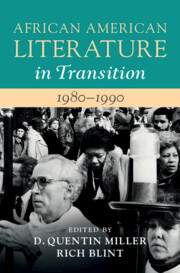Book contents
- African American Literature in Transition, 1980–1990
- African American Literature in Transition
- African American Literature in Transition, 1980–1990
- Copyright page
- Contents
- Notes on Contributors
- Preface
- Introduction
- Part I The Expanding Canon
- Part II New Directions/New Literary Forms
- 6 The Trey Ellis 1980s and the Discovery of an Artistic School
- 7 Hip-Hop in Transition
- 8 Reframing and Reappropriating Blackness in 1980s Satire
- Part III Global Connections
- Index
7 - Hip-Hop in Transition
from Part II - New Directions/New Literary Forms
Published online by Cambridge University Press: 02 February 2023
- African American Literature in Transition, 1980–1990
- African American Literature in Transition
- African American Literature in Transition, 1980–1990
- Copyright page
- Contents
- Notes on Contributors
- Preface
- Introduction
- Part I The Expanding Canon
- Part II New Directions/New Literary Forms
- 6 The Trey Ellis 1980s and the Discovery of an Artistic School
- 7 Hip-Hop in Transition
- 8 Reframing and Reappropriating Blackness in 1980s Satire
- Part III Global Connections
- Index
Summary
Black literature of the 1980s grew in conjunction with the multifaceted cultural phenomenon known as Hip-Hop. A key aspect of this growth was the subversion of Eurocentric rules and expectations. This mindset connected to deep African American traditions on multiple levels. First, in rejecting the general belief that art should be made in accordance with Eurocentric aesthetic principles, Hip-Hop took its place in a long line of African American literary and artistic forms that took that position either as an explicitly political statement, as a reflection of respect toward African American audiences, or as some combination.Second, Hip-Hop also questioned specific tenets of Eurocentric art, such as the idea that written literature was more sophisticated than oral literature, or that linear development was inherently superior to cyclical forms. Third, Hip-Hop developed aesthetic and pragmatic strategies for making art outside of a Eurocentric framework. Fourth, Hip-Hop drew upon Afro-Diasporic conceptual frameworks and traditions as the foundation of those strategies. Finally, it used artistic debates around all of these questions as part of the art itself.
Keywords
- Type
- Chapter
- Information
- African American Literature in Transition, 1980–1990 , pp. 139 - 159Publisher: Cambridge University PressPrint publication year: 2023

